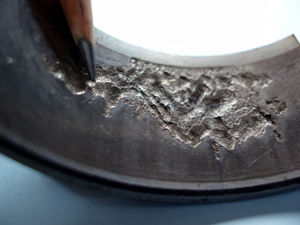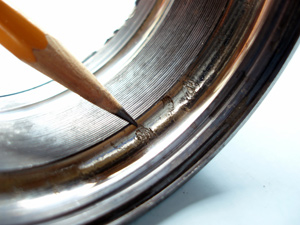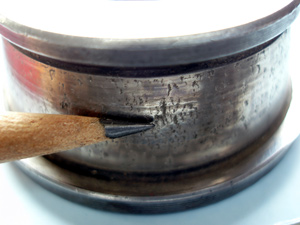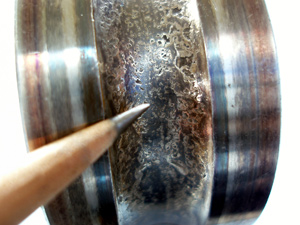While a wheel bearing must support its share of the vehicle’s weight, it must also maintain a perfect radial alignment with the axle. To illustrate, the instant a brake rotor deviates from a perfect 90-degree alignment with the axle, it pushes the caliper pistons into their bores and allows the brake rotor to drag against the pads.
Even with drum brakes, a wheel bearing must maintain the concentricity of the drum with that of the brake shoes. If the axle bearing allows vertical movement in the axle shaft, the axle shaft is no longer concentric with the brake drum or seal. The effects are dragging brakes and axle lubricant leaking past the axle seals onto the brake shoes.
WHEEL BEARING NOISES
Because most bearings are case-hardened metal, the bearing race begins to develop pits as the case-hardened metal fatigues and flakes away from the softer base metal. The result is a pitting or pothole effect on the bearing race, which causes a slight knocking or growling noise as the bearing becomes progressively worse. See Photo 1.
One of the difficulties of detecting a worn wheel bearing is that the double ball, sealed bearings used in modern front- and all-wheel-drive axles can develop a pit on the outer race that makes noise only under certain driving conditions. Unfortunately, wheel bearings generally wear only on the load-bearing side. When the vehicle is placed on a lift, the axle shafts are suspended and the bearing begins to roll on the non-load bearing side, which eliminates most of the rotating noise. See Photo 2.
On the positive side, worn wheel bearings tend to have more end play than normal when suspended from a lift. Excessive end play can be detected by grabbing the wheel at the six and twelve o’clock positions and forcefully tipping it in and out. Unless otherwise specified, most sealed bearings should have no noticeable end play.
To further complicate bearing diagnostics, wheel bearing noises tend to travel through the drivetrain and exit through a transmission or engine mount that’s “grounding” the noise from the drive train to the chassis. This grounding effect causes a wheel bearing noise to be transferred far from its point of origin. For these and other reasons, it’s often very difficult to detect the early stages of wheel bearing failure.
Worn wheel bearings can often be detected by rocking the vehicle from side to side at low speeds with the steering wheel. This technique tends to increase the load on the bearings, causing the pitted bearing to become noisier than usual. This test works better when the vehicle is warm and in a parking area or roadway with light traffic. A more sophisticated method for locating a bad bearing is to attach a set of “chassis ears” to each wheel location to monitor bearing noise using the same driving technique.
One technical tip from the International Automotive Technicians Network (iATN) says that a bad wheel bearing might be detected touching the wheel’s coil spring and spinning the wheel. Vibrations in the spring indicate a bad wheel bearing. While I haven’t verified that technique, it’s certainly worth a try.
Once removed for inspection, a new tapered roller bearing cup lubricated by grease and operating with a few thousandths of an inch of end play should have a polished, slightly cross-hatched surface. If the bearing has been operating with excessive end play, the tapered rollers have become barrel-shaped and will not hold the hub perpendicular to the axle. If the polish is gone and the cross-hatch is worn away, the bearing should be discarded.
In contrast, a correctly preloaded bearing running in oil should display a frosted appearance on the race. Preload on bearings are tested by using an inch-pound torque wrench to measure the torque required to turn the shaft. Any bearing that’s pitted, discolored, water-etched, or scored should be discarded. See Photo 3.
DRIVETRAIN BEARING NOISES
Sometimes, the growling bearing noise we hear is generated in the vehicle’s drivetrain. In general, automatic transmissions use bushings rather than ball or tapered roller bearings to support loads, so the bushings rarely cause a noise. Manual transmissions, on the other hand, do use ball tapered, and straight roller bearings in their input, counter and output shafts.
If the growling noise were more noticeable in a specific gear range, a worn bearing in the transmission would generally cause the bearing noise. If the bearing noise is constant regardless of acceleration or deceleration and is approximately three times wheel speed in frequency, the faulty bearing would generally be found on the transmission output shaft or the driveshaft intermediate support bearing.
Regarding hypoid gear drive axles, worn pinion bearings generally react directly to acceleration and deceleration and, like the driveshaft, occur at approximately three times wheel speed frequency. The rear pinion gear bearing takes the brunt of engine torque and generally is the first to fail. For this reason, a worn rear pinion bearing is generally more noticeable on acceleration.
The front pinion bearing is usually smaller because its main function is to maintain a correct gear tooth contact pattern between the pinion gear and the axle ring gear. If the rear pinion bearing wears enough to lose its preload with the front bearing, the axle gears will generally whine during deceleration because the pinion depth changes a few thousandths of an inch.
Ring gear carrier bearing noises are more difficult to diagnose because they rotate at wheel speed. A simple test for drive axle bearing wear is to simply drain the axle oil into a clean drain pan. If the magnetic fluid level or drain plug is abundantly covered with iron filings or the oil has the telltale “aluminum paint” appearance, the drive axle assembly likely has badly worn bearings. See Photo 4.
REMOVING BEARINGS
All too often, inexperienced techs can seriously injure themselves and permanently damage the new bearings themselves by using improper installation techniques. Because bearings are brittle and likely to shatter like glass, it’s extremely important to wear shatterproof safety glasses and to cover the bearing with a scatter shield when pressing the bearing on or off a shaft.
Although using an acetylene cutting torch is one method of removing a stubborn bearing from a housing or shaft, a technician can weaken an axle by overheating it or by nicking it with the torch. If the bearing is held onto the axle with a pressed-on lock ring, the axle seal surface can be protected by covering it with a worm-drive hose clamp while the lock ring is cut half through with a high-speed cutoff wheel. The lock ring can then be fractured by tapping a slim, cold chisel into the cut.
REPLACING BEARINGS
Several OE and aftermarket tool manufacturers supply tools to install sealed ball bearings in front-wheel and all-wheel drive applications. These tools not only guarantee a flawless installation, but also drastically reduce the installation time required for the bearing replacement.
In applications such as pinion bearings on drive axle pinion gears, the installation can be eased by first cleaning rust and dirt from the pinion shaft and then lightly coating the shaft with hypoid gear oil. Heating the inner race in an old toaster oven can ease installation of the separate inner races. Conversely, cooling them in the freezer compartment of the shop’s refrigerator can ease installation of outer races.
Press adapters can be made by cutting a slot in an old bearing race with a high-speed cut off wheel. The slot allows the bearing race to be easily removed from the axle housing or shaft. Last, because common round punches tend to distort bearing races or cups, bearing race drivers available from tool suppliers should be used to drive wheel bearing races into hubs whenever possible.
CLEANLINESS EQUALS LONG LIFE
Always use a high-temperature, bearing-rated or manufacturer-specified grease to repack new or used wheel bearings. While highly resistant to water, common chassis lubricants seldom provide the high-temperature lubrication characteristics needed by wheel bearings.
It’s important to install new seals because dirt and moisture contamination can quickly ruin a new wheel bearing. When installing the new seal, polish the oil sealing surface with fine emery or crocus cloth and don’t forget to lubricate the new oil seal before installing. If manual transmission or drive axle pinion and ring gear bearing are being replaced, clean the axle housing as thoroughly as possible with solvent followed by high-pressure soap and water. Install a magnetic fluid level check plug or, as a last resort, epoxy a small magnet in an appropriate location on the axle cover to pull any remaining small steel particles from the axle oil. Remember that cleanliness is vital for long bearing life.













